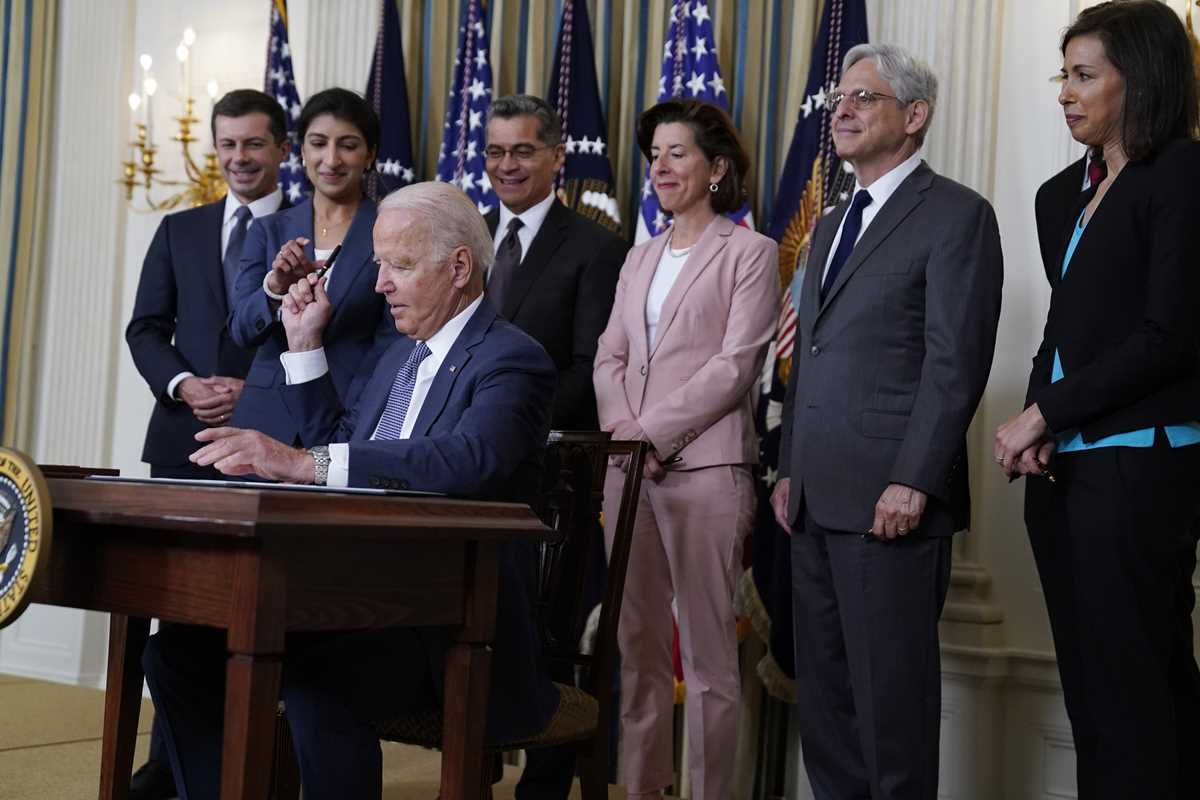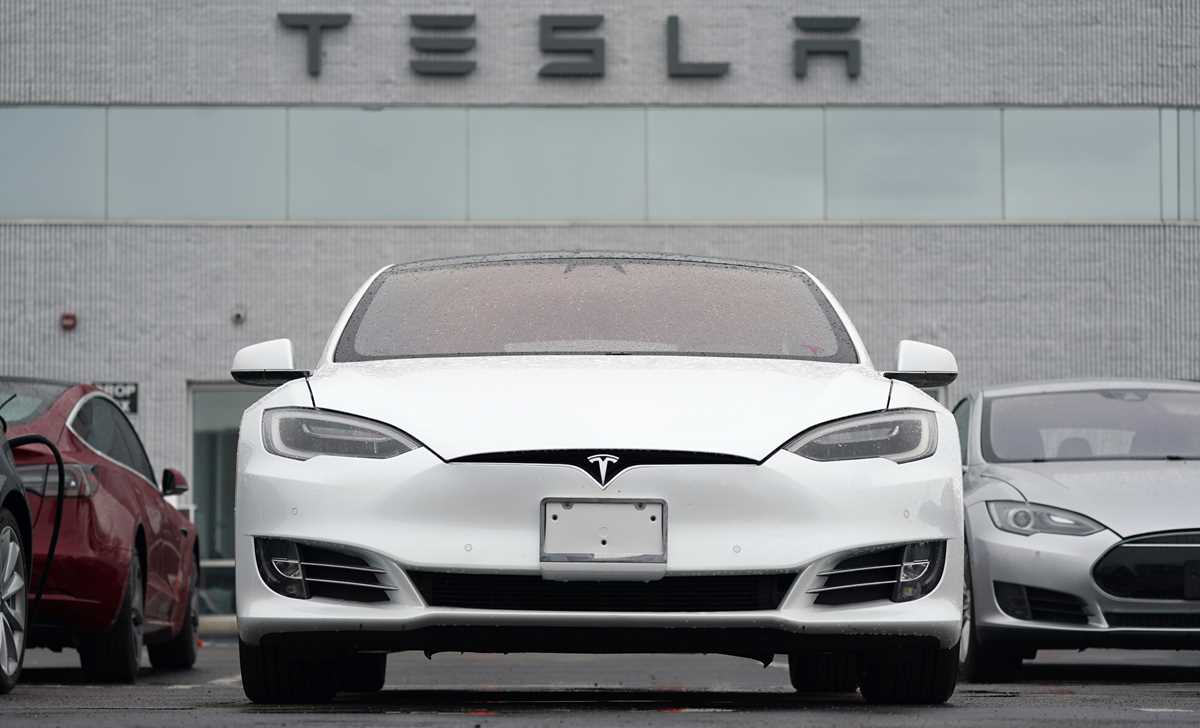 President Joe Biden hands out a pen after signing an executive order aimed at promoting competition in the economy, in the State Dining Room of the White House, Friday, July 9, 2021, in Washington. Standing from left, Transportation Secretary Pete Buttigieg, Lina Khan, Chair of the Federal Trade Commission, Health and Human Services Secretary Xavier Becerra, Commerce Secretary Gina Raimondo, Attorney General Merrick Garland, National Economic Council director Brian Deese, obscured, and Jessica Rosenworcel, Acting Chairwoman of the Federal Communications Commission. (AP Photo/Evan Vucci)
President Joe Biden hands out a pen after signing an executive order aimed at promoting competition in the economy, in the State Dining Room of the White House, Friday, July 9, 2021, in Washington. Standing from left, Transportation Secretary Pete Buttigieg, Lina Khan, Chair of the Federal Trade Commission, Health and Human Services Secretary Xavier Becerra, Commerce Secretary Gina Raimondo, Attorney General Merrick Garland, National Economic Council director Brian Deese, obscured, and Jessica Rosenworcel, Acting Chairwoman of the Federal Communications Commission. (AP Photo/Evan Vucci) Administrator of the Environmental Protection Agency Michael Stanley Regan, left, is welcomed by Italian Minister for Ecological Transition Roberto Cingolani as he arrives at Palazzo Reale in Naples, Italy, Thursday, July 22, 2021, to take part in a G20 meeting on environment, climate and energy. (AP Photo/Salvatore Laporta)
Administrator of the Environmental Protection Agency Michael Stanley Regan, left, is welcomed by Italian Minister for Ecological Transition Roberto Cingolani as he arrives at Palazzo Reale in Naples, Italy, Thursday, July 22, 2021, to take part in a G20 meeting on environment, climate and energy. (AP Photo/Salvatore Laporta) This Sunday, May 9, 2021 file photo shows vehicles at a Tesla location in Littleton, Colo. Tesla delivered 201,250 vehicles in the second quarter, an improvement over first-quarter figures but below the expectations of Wall Street analysts. Tesla and other automakers have been hampered by a global shortage of computer chips. (AP Photo/David Zalubowski)
This Sunday, May 9, 2021 file photo shows vehicles at a Tesla location in Littleton, Colo. Tesla delivered 201,250 vehicles in the second quarter, an improvement over first-quarter figures but below the expectations of Wall Street analysts. Tesla and other automakers have been hampered by a global shortage of computer chips. (AP Photo/David Zalubowski) President Joe Biden holds a meeting with his Cabinet in the Cabinet Room at the White House in Washington, Tuesday, July 20, 2021. From left, Deputy Director of the Office of Management and Budget Shalanda Young, Secretary of Education Secretary Miguel Cardona, Secretary of Health and Human Services Secretary Xavier Becerra, Secretary of the Interior Secretary Deb Haaland, Secretary of State Antony Blinken, Biden, Secretary of Defense Lloyd Austin, Secretary of Commerce Secretary Gina Raimondo and Transportation Secretary Pete Buttigieg. (AP Photo/Susan Walsh)
President Joe Biden holds a meeting with his Cabinet in the Cabinet Room at the White House in Washington, Tuesday, July 20, 2021. From left, Deputy Director of the Office of Management and Budget Shalanda Young, Secretary of Education Secretary Miguel Cardona, Secretary of Health and Human Services Secretary Xavier Becerra, Secretary of the Interior Secretary Deb Haaland, Secretary of State Antony Blinken, Biden, Secretary of Defense Lloyd Austin, Secretary of Commerce Secretary Gina Raimondo and Transportation Secretary Pete Buttigieg. (AP Photo/Susan Walsh)WASHINGTON (AP) — In a major step against climate change, President Joe Biden is proposing a return to aggressive Obama-era vehicle mileage standards over five years. He's then aiming for even tougher anti-pollution rules after that to forcefully reduce greenhouse gas emissions and nudge 40% of U.S. drivers into electric vehicles by decade’s end.
The proposed rules from the Environmental Protection Agency and Department of Transportation are expected to be released as early as next week, according to four industry and government officials who have been briefed on the plan.
They spoke on the condition of anonymity because the standards haven’t been finalized. But administration officials have been discussing the numbers with the auto industry.
Making good on Biden’s promise during the presidential campaign, the regulatory action would tighten tailpipe emissions standards rolled back under President Donald Trump.
Acknowledging Biden’s goal of cutting U.S. greenhouse gas emissions by at least half by 2030, the rules would begin with the 2023 car model year and start by applying California's 2019 framework agreement on emissions standards reached between Ford, Volkswagen, Honda, BMW and Volvo, according to three of the officials. The California deal increases the mileage standard and cuts greenhouse gas emissions by 3.7% per year.
Requirements ramp up in 2025 to Obama-era levels of a 5% annual increase in the mileage standard and a similar cut in emissions. They then go higher than that for model year 2026, one of the people said, perhaps in the range of 6% or 7%.
Neither EPA nor the Transportation Department would comment on the proposal.
The new standards go partway in meeting the demand from environmental groups, several of which were pushing for a quick return to at least the Obama-era standards to counteract the Trump rollbacks. Car emissions are the single biggest U.S. contributor to climate change.
“We're at the climate cliff, and the stakes are too high to aim low,” the Center for Biological Diversity will write in a full-page ad in The New York Times on Wednesday urging strong action.
The center is pushing for a phase-out of gas-powered vehicles in favor of electrics by 2030, as well as a requirement for 7% annual emissions reductions each year from 2027 until then.
In the proposed rule, the EPA is likely to make a nonbinding statement that the requirements will ramp up even faster starting in 2027, forcing the industry to sell more zero-emissions electric vehicles, the industry and government officials said. For now, the agency was seeking to ask that 40% of all new car sales to be electric vehicles by 2030, according to one of the officials.
The Biden administration defers for now in setting post-2026 mileage requirements, setting the stage for bigger fights ahead over the level of government effort needed to combat climate change against the future of the auto industry, which currently draws most of its profits from gas-powered SUV sales.
Delaware Sen. Tom Carper, who chairs the Senate Environment and Public Works Committee, has been urging tough rules that would ban sales of new gasoline-powered passenger vehicles by 2035. He's argued that the industry is already moving in the direction of zero-emission electric vehicles.
Under Obama, automakers were required to raise fuel economy 5% per year from 2021 through 2026. But under Trump, that was reduced to 1.5% annually. In 2019, five automakers — Ford, BMW, Honda, Volkswagen and later Volvo — split with competitors and reached a deal with California to raise mileage by 3.7% per year.
Trump later repealed California’s legal authority to set its own standards, which the Biden administration is moving to restore.
The Trump rollback of the Obama-era standards would require a projected 29 miles per gallon in “real world” stop and start driving by 2026. That’s well below the requirements of the Obama administration rules that would have increased it to 37 mpg.
The California deal with Ford and the other automakers has vehicles getting about 33 mpg on average, according to environmental groups, after accounting for credits for electric vehicles.
It wasn’t clear whether the Biden administration would restore credits for selling electric vehicles, but that is likely since EVs are a cornerstone of its plan to fight climate change. Biden’s nearly $2 trillion infrastructure proposal includes 500,000 new charging stations for electric cars and trucks, and he has proposed tax credits and rebates to help spur sales.
Under the Obama-era standards, automakers got double credit for fully electric vehicles toward meeting their fuel economy and pollution requirements. That “multiplier” was removed in the Trump rollback.
Several automakers including GM have expressed a commitment to transition to all electric vehicle sales, though environmental groups are skeptical the companies will stick to their promises if consumers continue to favor gas-powered cars, which now cost less. Potentially easing the transition for automakers is a nearly trillion-dollar bipartisan Senate infrastructure bill that would help fund the half-million new electric charging stations around the country. An accompanying $3.5 trillion Senate spending bill backed by Democrats was expected to provide tax credits and other incentives for consumers to switch to electric vehicles.
Those measures are still pending in Congress.
The move comes at a time when Americans are buying record numbers of less-efficient pickup trucks and SUVs, which will make it harder for the industry to comply. So far this year, more than three-quarters of U.S. new vehicle sales were trucks, vans and SUVs, according to Edmunds.com. Fewer than a quarter were more efficient cars.
Only three automakers — Tesla, Honda and Subaru — complied with the standards in 2019, the latest year figures are available from the EPA. The rest had to use fuel efficiency credits from previous years or buy electric vehicle credits from other automakers to hit their goals.
Fully electric vehicles represent just 2% of new vehicle sales in the U.S., but analysts expect that to rise rapidly in coming years.
Earlier this year as negotiations were starting, a coalition of automakers told the Biden administration it would agree to raise mileage standards to reduce tailpipe emissions but with tradeoffs and at rates lower than those brokered by California and the five other automakers. The automakers would have agreed to stricter standards in exchange for the added credits for selling electric vehicles.
___
Krisher reported from Detroit.
Before you consider General Motors, you'll want to hear this.
MarketBeat keeps track of Wall Street's top-rated and best performing research analysts and the stocks they recommend to their clients on a daily basis. MarketBeat has identified the five stocks that top analysts are quietly whispering to their clients to buy now before the broader market catches on... and General Motors wasn't on the list.
While General Motors currently has a "Moderate Buy" rating among analysts, top-rated analysts believe these five stocks are better buys.
View The Five Stocks Here
Wondering when you'll finally be able to invest in SpaceX, StarLink, or The Boring Company? Click the link below to learn when Elon Musk will let these companies finally IPO.
Get This Free Report